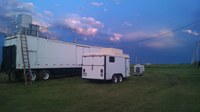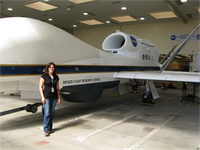Amber Emory: A Series of Storms
Storms rolled in across a lake in upstate New York. A young girl watched, transfixed, from the widest window in the house. Most children her age scattered in the face of thunderstorms, but not Amber Emory. She curled up in her storm-watching chair, a chair she still won’t let her mother throw out, to experience the rain and lightning as close as she could.
“I think I started doing that when I was three,” Emory said. “From a young age, I loved watching the power of storms.”
Emory now works at NASA’s Goddard Space Flight Center in Greenbelt, Maryland, evaluating how satellite-based radar on the Global Precipitation Measurement mission performs and how it expands scientists’ abilities to measure rain and snow from space. She still loves storms.
Hail
Years after watching those first storms, a college freshman, Emory, drove home from summer courses at Pennsylvania State University in State College, where she was majoring in business.
The sky gradually darkened and hail began to fall. In the midst of hail and torrential rain, Emory pulled over to the side of the road to wait for the storm to subside.
“At that point I had an epiphany,” Emory said. “I wanted to figure out why I didn’t know that the storm was coming and what had happened.”
Shortly thereafter, she changed her major from business to meteorology.
Storm Fronts
Gusts of cool air billowed out ahead of storm clouds forming on the horizon. A couple of years into her undergraduate career, Emory drove a car fitted with special instrumentation into the storm. Before long, she turned around and drove back out.
“You have what’s called a cold pool and that kind of surges out underneath the storm, but as it’s doing that, it’s encountering warm, moist air ahead and generating an updraft that feeds the storm,” Emory said. “I was tasked with sampling that.”
It was perhaps not the most exciting moment in storm-chasing history, but the undergrad had just experienced a thrill she would pursue for years to come. The following summer, she graduated to chasing tornados.
Tornados
Less than a quarter mile from its damaging winds, Emory watched a tornado rip roofs off buildings and lift cars into the air. For several summers she lived out the movie “Twister” in the Midwest, working alongside seasoned storm chasers.
Standing so close to that powerful tornado was one of the scariest moments of her storm-chasing career, she said.
“You have to have a healthy respect for Mother Nature,” she said. “You don’t play around with severe weather. The goal is to get the data set, but also to live to chase again.”
Hurricanes
An unmanned aerial vehicle soared 50,000 feet above lightning-producing regions of a hurricane. Emory, the only meteorologist on the Global Hawk’s control team, watched the weather from the ground to keep the UAV safe. She remained awake and on the edge of her seat for the entire 26-hour flight.
“That’s a huge responsibility: to not let the bird, the Global Hawk, with all of our expensive instruments on it, fall out of the sky,” Emory said. “I think I was up for a total of about 28 hours before I [slept]. Even though you’re tired, you have to be dedicated.”
As part of the Generation and Rapid Intensification Processes study, their data helped characterize the lifecycle of hurricanes.
Rain

After years of studying destructive storms, Emory embarked on a calmer chase this year. It was a series of firsts: the first field campaign for the Plains Elevated Convection At Night (PECAN) experiment, first use of the first radar she built. She studied nocturnal precipitation systems in the lowest layer of Earth’s atmosphere.
“We were night owls,” she said. “My radar is a stationary one, so we set it up and it transmits straight vertically, so we learned more about these great rain-producing events.”
She set up side-by-side with NASA colleagues who used light detection and ranging, or LIDAR, technology to study the same phenomenon.
“Field campaigns can push you to the limits,” Emory said. In one instance, she remembered spending a 14-hour day sitting in a cow field with a radar while passersby eyed her team and their equipment suspiciously. “But when you have a perfect day, when you get a perfect data set, you remember where you were and it makes it all worth it.”
Ashley Morrow
NASA's Goddard Space Flight Center, Greenbelt, Maryland

